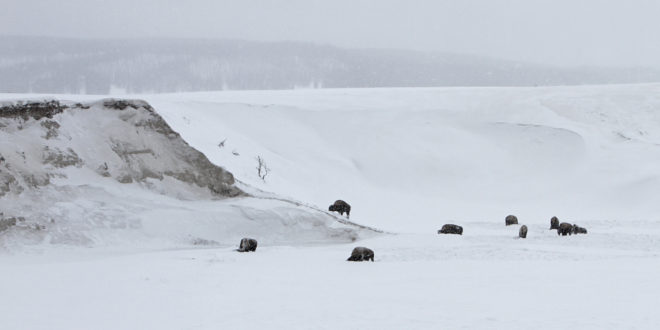A Montana rep has proposed a bill that strip a requirement that bison be brucellosis-free before being transported out of Yellowstone National Park.
According to the Bozeman Daily Chronicle, Representative Willis Curdy (D-Missoula) submitted House Bill 419 to the House Agriculture Committee Thursday. You can see info about the bill here.
If passed, HB 419 would remove a major barrier to current efforts to found a quarantine program at Fort Peck Indian Reservation. Indeed, it would fundamentally alter how state and federal officials manage Yellowstone’s bison population, opening avenues besides the current system of corralling, culling, and hunting.
A few weeks ago, we reported that 25 bull bison would be sent to Fort Peck after being moved to a USDA corral at Corwin Springs, just north of Yellowstone. Those 25 are part of 40 bison originally promised to Fort Peck, which had been held at Stephens Creek since late 2015. Those 40 were originally slated for slaughter, to make room for the ambitious quota proposed under this year’s winter plan.
Montana Governor Steve Bullock temporarily halted operations at Stephens Creek in an effort to get the bison to Fort Peck. After negotiations, state livestock officials agreed to put aside the aforementioned bulls. The remaining 15, all female, would be culled. Shipment of bison from Stephens Creek to slaughter began February 8, 2017.
In a statement, Fort Peck Tribal Chairman Floyd Azure said that officials had “slapped the Fort Peck tribes in the face” by divvying up the 40 bison, though he was glad for Bullock’s intervention. The Fort Peck quarantine facility can hold up to 500 bison; tribal officials say they hope the facility will become a source of genetically-pure bison that will be used to repopulate herds across the bison’s original range.
Curdy, according to the Chronicle, cited this recent imbroglio in his decision to propose HB 419. “House Bill 419 is designed to address one technical point in Montana law,” Curdy added. From the Chronicle:
The bill garnered support from wildlife advocates and tribal officials, who said the law hasn’t been applied consistently and was a discriminatory roadblock to sending bison to Native American tribes. Dennis Jorgensen, with the World Wildlife Fund, said that the law would fix a redundancy and that the law as it is now is akin to requiring a sick person be deemed healthy before they can see a doctor.
“In order to be sent to tribes to be quarantined, Yellowstone bison must first be quarantined,” Jorgensen said. “It’s clearly redundant.”
But agriculture groups lined up in opposition, citing worries about brucellosis transmission and the potential for the cattle industry to suffer if wild bison are sent to new areas in the state.
“The law that we have in place and the way that the Department of Livestock is currently managing the species is working,” said Nicole Rolf of the Montana Farm Bureau Federation, adding that the changes the bill proposes “would potentially put our industry in jeopardy.”
About 5,500 bison live in Yellowstone now, and a 17-year-old management plan fueled by fears of brucellosis calls for a population of about 3,000. Wildlife mangers want to kill about 1,300 bison this year to reduce the herd’s number, which they do through hunting and slaughter.
In 2016, Yellowstone National Park proposed establishing a quarantine program at Fort Peck, both as a way to augment other bison herds and to reduce the number shipped to slaughter each year. But state livestock officials blocked the move citing the portion of state law that requires wild bison be certified brucellosis-free before they can be transported and released somewhere else.
The Fort Peck Tribes have built a quarantine facility that meets federal standards. It can hold up to 500 animals, and they want to use it to augment other bison herds around the country. But representatives of the tribe said Thursday that they need this bill to become law for that to begin.
“This change in the law would allow use of that facility and it would allow the tribes to be a meaningful partner in this whole dilemma,” said Majel Russell, an attorney with the Fort Peck Tribes.
Although bison have become the poster animals of brucellosis danger in Montana’s ag industry, more and more studies point to Yellowstone’s elk posing a greater risk of brucellosis transmission to cattle. And elk, of course, are managed quite differently from bison.
According to the Chronicle, Yellowstone officials have rounded up around 400 bison for slaughter and plan to capture more. Operations are slated to continue through March. Meanwhile, the Montana Fish, Wildlife and Parks agency has reported that hunters have shot nearly 400 bison since the season began.
 Yellowstone Insider Your Complete Guide to America's First National Park
Yellowstone Insider Your Complete Guide to America's First National Park





